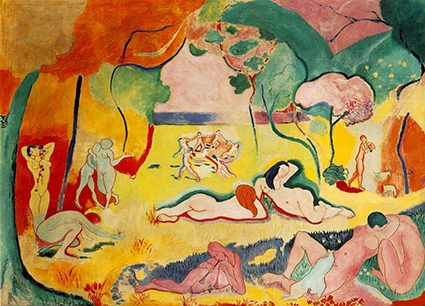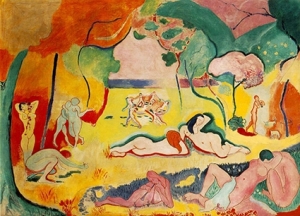Matisse and the Fauves
October can hardly be imagined without the Salon d’Automne – the Autumn Salon founded in Paris in the basement of the Petit Palais, initially organised by artists Georges Rouault, Andre Derain, Henri Matisse and Albert Marquet as a reaction to the conservative policies of the official Paris Salon. The exhibition almost immediately became the showpiece of developments and innovations in 20th century painting and sculpture. The Salon d’Automne shaped modern and contemporary art in the 20th century. At the expense of the riotous scandals, the Salon established its reputation and avant-garde movements: Fauvism, Cubism, Surrealism, Dadaism, the School of Paris, Abstraction, Op Art, and so on. In this article we would like to focus on one of the founders of Salon d’Automne, artist Henri Matisse.
On seeing the work of Matisse in Room VII at the Salon d’Automne in Paris in 1905, the critic Louis Vauxcelles named it “un Donatello parmi les fauves, ‘Donatello among the wild animals’ which gave the name “Fauves” to the group of artists that painted in a style similar to Matisse. The wildness lay in the lurid colours and aggressive execution of the paintings. Matisse’s portrait of his wife, ‘Woman in a Hat’, for instance, showed her with a face blotched with green, pink and yellow under a hairdo in brick red and cobalt blue, as well as a giant purple hat with multi-coloured feathers. In spite of severe critique and discouragement, Matisse’s Woman with a Hat, was bought by Gertrude and Leo Stein. Matisse was recognised as a leader of the Fauves, along with Andrй Derain and Maurice de Vlaminck; the two were friendly rivals, each with his own followers. Other members of the Fauvist movement were Georges Braque and Raoul Dufy. The Symbolist painter Gustave Moreau was the movement’s inspirational teacher.
Le bonheur de vivre (The Joy of Life) is another world famous masterpiece by Henri Matisse. It is regarded as one of the pillars of early modernism. The monumental canvas was first exhibited at the Salon des Independants in 1906. In the picture are shown a number of nude women and men in a landscape drenched with vivid color. Its cadmium colors and spatial distortions initially caused public protest and outrage. The decline of the Fauvist movement after 1906 did not affect the career of Matisse. Many of his finest works were created between 1906 and 1917, when he was an active part of the great gathering of artistic talent in Montparnasse.
Matisse had a long association with Russian art collector Sergei Shchukin. He created one of his major works ‘La Danse’ especially for Shchukin as part of a two painting commission, the other painting being ‘Music’ in 1910. An earlier version of ‘La Danse’ (1909) is in the collection of the Museum of Modern Art in New York City. The painting shows five dancing figures, painted in a strong red, set against a very simplified green landscape and deep blue sky. It reflects Matisse’s incipient fascination with primitive art, and uses a classic Fauvist color palette: the intense warm colors against the cool blue-green background and the rhythmical succession of dancing nudes convey the feelings of emotional liberation and hedonism.
Later, when painting and sculpture became physical challenges for the artist due to illness, Matisse turned to a new type of medium. With the help of his assistants, he began creating cut paper collages, or decoupage whereby he would cut sheets of paper, pre-painted with gouache by his assistants, into shapes of varying colours and sizes, and arrange them to form lively compositions. Initially, these pieces were modest in size, but eventually transformed into murals or room-sized works. The Henri Matisse Museum in Nice features a wonderful collection of his early works, sculptures and cutouts. Situated on a picturecue hill overlooking Nice, it offers insights into the artist’s career, various stages of his work, as well as a wonderful collection of vases that Matisse created in his house.
Lily Fьrstenow-Khositashvili











